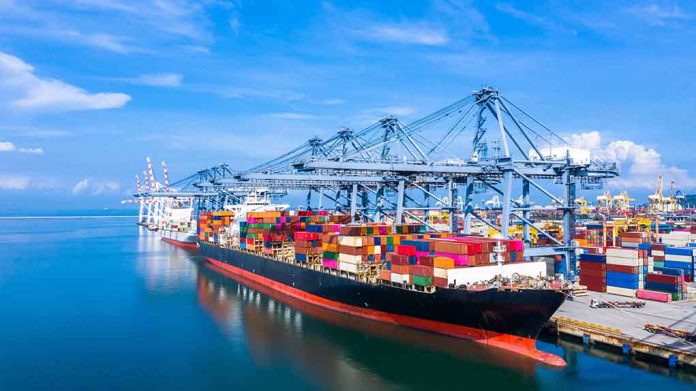
East Coast ports brace for potential strike as dockworkers and operators clash over automation.
At a Glance
- The International Longshoremen’s Association (ILA) contract expires on January 15, risking a strike at East and Gulf coast ports
- Negotiations have stalled over automation, with the union concerned about job security
- A strike could cost between $5 billion and $10 billion per day
- President-elect Donald Trump has expressed support for the dockworkers
- Carriers and shippers are preparing contingency plans for possible supply chain disruptions
Looming Strike Threatens East Coast Ports
As the January 15 deadline approaches, the International Longshoremen’s Association (ILA) and the United States Maritime Alliance (USMX) are set to resume critical contract negotiations next week. The talks, which have stalled over the contentious issue of automation, could determine whether East and Gulf coast ports face a crippling strike. With nearly half of the U.S.’s container volumes at stake, the potential for widespread economic disruption looms large.
The core of the dispute centers on the future of port operations. USMX advocates for increased automation to enhance efficiency, while the ILA staunchly opposes any measures that could threaten job security. This impasse has already led to the cancellation of previous talks in November, with ILA President Harold Daggett taking a firm stance against automation, including semi-automated cranes.
Economic Impact and Industry Response
The potential strike has sent ripples through the shipping industry, prompting carriers and logistics companies to prepare for the worst. Maersk, a major player in global shipping, has stated they are “actively developing contingency plans to minimise the impact of any labour disruptions.” Similarly, Hapag-Lloyd plans to introduce surcharges of $850 per TEU for imports to affected ports starting January 20, to cover additional costs from potential strikes.
The economic stakes are enormous. Experts estimate that a strike could cost between $5 billion and $10 billion per day. While short-term impacts might be minimal due to existing inventory, a prolonged strike could lead to empty shelves and significant supply chain disruptions. “In the short term, there will be no impact because the inventory is here. If this goes two to three weeks, then you will start seeing empty shelves…it would be a big problem,” the executive warned.
Political Implications and Trump’s Stance
Adding another layer of complexity to the negotiations is the upcoming inauguration of Donald Trump as the 47th U.S. president. Trump has expressed support for the dockworkers, potentially influencing the dynamics of the talks. His stance on automation aligns with the union’s concerns, as evidenced by his statement: “I’ve studied automation, and know just about everything there is to know about it. The amount of money saved is nowhere near the distress, hurt, and harm it causes for American Workers, in this case, our Longshoremen.” Trump’s comments have led to speculation that he might pressure ocean carriers to concede or position himself as a mediator in the dispute.
This political backdrop complicates an already tense situation. Industry analyst Peter Tirschwell suggests that Trump’s involvement could significantly influence the negotiations’ outcome, potentially tipping the scales in favor of the union’s demands.
The Road Ahead
As the January 7 resumption of talks approaches, both sides face immense pressure to reach an agreement. The ILA’s firm stance against automation, coupled with the USMX’s argument that restricting technology would hinder the industry’s evolution, presents a significant challenge. The outcome of these negotiations will not only affect the immediate future of East and Gulf coast ports but could also set a precedent for how the shipping industry addresses automation and job security in the years to come.
With the clock ticking and billions of dollars at stake, the eyes of the nation are fixed on these crucial talks. The potential for a strike threatens to disrupt not just the shipping industry, but the entire U.S. economy, underscoring the critical importance of finding a resolution that balances technological progress with worker protection.
Sources:
East Coast Port Strike Looms as Contract Talks Stall, Carriers Brace for Impact
East Coast dockworkers, port operators to resume talks next week as strike fears mount













